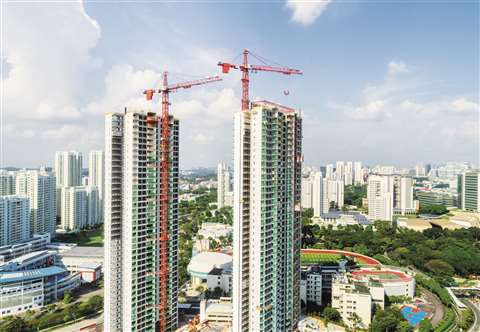High-rise construction projects have become increasingly common in urban areas, with tower cranes playing a crucial role in their completion. These towering machines are responsible for lifting and moving heavy materials, allowing construction workers to build upwards with ease. In this article, we will explore the importance of tower cranes in high-rise construction and the various challenges they face at the pinnacle of these projects.
The Evolution of Tower Cranes in High-Rise Construction
Tower cranes have played a crucial role in the evolution of high-rise construction. These towering machines have revolutionized the way tall buildings are built, making it possible to construct structures that reach unprecedented heights. Over the years, tower cranes have undergone significant advancements, becoming more efficient, powerful, and versatile. The introduction of hydraulic systems and computerized controls has greatly improved their performance and safety. Additionally, the use of lighter materials and innovative designs has allowed for increased lifting capacities and greater reach. Tower cranes have become an indispensable tool in the construction industry, enabling the construction of iconic skyscrapers that shape the modern skyline.
The Role of Tower Cranes in Building Skyscrapers

Tower cranes play a crucial role in the construction of skyscrapers. These tall and powerful machines are used to lift and move heavy materials and equipment to great heights. With their long booms and high lifting capacities, tower cranes can reach the top of even the tallest buildings. They are essential for tasks such as placing steel beams, concrete panels, and other building components in the right position. Tower cranes are also used to transport workers and tools to different levels of the construction site. Their stability and precision make them indispensable in ensuring the safe and efficient construction of skyscrapers.
Safety Measures and Challenges in Operating Tower Cranes
Tower cranes are essential in the construction industry, but they also pose significant safety challenges. To ensure the safety of workers and the public, several measures must be implemented. Firstly, regular inspections and maintenance of tower cranes are crucial to identify any potential issues and prevent accidents. Secondly, operators must be properly trained and certified to operate these complex machines. Additionally, strict adherence to safety protocols, such as wearing personal protective equipment and following proper lifting procedures, is essential. Despite these safety measures, challenges still exist, including adverse weather conditions and the potential for human error. Therefore, continuous monitoring and improvement of safety practices are necessary to mitigate these risks and ensure the safe operation of tower cranes.
The Impact of Tower Cranes on Urban Skylines
Tower cranes have a significant impact on urban skylines, transforming the cityscape and shaping the visual identity of a city. These towering structures, often seen on construction sites, symbolize progress and development. Their presence signifies a growing economy and a thriving urban environment. Tower cranes not only facilitate the construction of high-rise buildings but also serve as a testament to human ingenuity and engineering prowess. Their imposing height and sleek design add a sense of grandeur to the skyline, creating a striking contrast against the surrounding buildings. Tower cranes have become iconic symbols of urbanization and modernization, leaving a lasting impression on both residents and visitors alike.
Innovations in Tower Crane Technology for High-Rise Construction
In recent years, there have been significant innovations in tower crane technology that have revolutionized high-rise construction. These advancements have greatly improved efficiency, safety, and productivity on construction sites. One notable innovation is the development of self-erecting tower cranes, which eliminate the need for manual assembly and disassembly. This not only saves time but also reduces the risk of accidents during crane setup. Additionally, the integration of advanced automation and control systems has allowed for more precise and efficient crane operation. This has resulted in faster construction timelines and reduced costs. Overall, these innovations in tower crane technology have greatly benefited the high-rise construction industry.
The Future of Tower Cranes in the Era of Sustainable Skyscrapers
As the world moves towards a more sustainable future, the construction industry is also adapting to meet the demands of sustainable skyscrapers. Tower cranes, a crucial component in the construction of these towering structures, are also undergoing changes to align with sustainability goals. One of the key advancements in tower crane technology is the use of electric power instead of diesel. Electric tower cranes not only reduce carbon emissions but also minimize noise pollution, making them more environmentally friendly. Additionally, these cranes are equipped with advanced sensors and automation systems, improving safety and efficiency on construction sites. With these innovations, tower cranes are set to play a vital role in the era of sustainable skyscrapers.
Conclusion
In conclusion, tower cranes play a crucial role in high-rise construction, allowing for the efficient and safe movement of heavy materials and equipment. These towering machines have revolutionized the construction industry, enabling the construction of skyscrapers that were once unimaginable. As technology continues to advance, it is likely that tower cranes will become even more sophisticated, further enhancing the capabilities and efficiency of high-rise construction.
What is a tower crane?
A tower crane is a type of crane that is used in the construction industry to lift and move heavy materials and equipment to high elevations. It consists of a vertical mast, a horizontal jib, and a counterweight system.
How does a tower crane work?
A tower crane works by using a combination of a vertical mast and a horizontal jib to lift and move heavy loads. The mast is fixed to the ground and provides stability, while the jib extends horizontally to reach the desired location. The crane’s lifting capacity is determined by the length of the jib and the counterweight system.
What are the advantages of using tower cranes in high-rise construction?
Tower cranes offer several advantages in high-rise construction. They have a high lifting capacity, allowing for the movement of heavy materials and equipment to great heights. They also have a long reach, which enables them to access different areas of the construction site. Additionally, tower cranes are highly stable and can withstand strong winds and other adverse weather conditions.
Are tower cranes safe to use in high-rise construction?
Yes, tower cranes are considered safe to use in high-rise construction when operated by trained professionals. They are designed to be stable and have safety features such as limit switches and overload protection systems. However, it is important to follow proper safety protocols and conduct regular inspections to ensure the safe operation of tower cranes.
How are tower cranes assembled and disassembled?
Tower cranes are typically assembled and disassembled using a smaller mobile crane. The components of the tower crane, such as the mast sections and jib, are lifted and secured into place one by one. During disassembly, the process is reversed, and the components are carefully lowered and removed. This process requires skilled operators and adherence to safety procedures.
What are the limitations of using tower cranes in high-rise construction?
While tower cranes offer many advantages, they also have some limitations. One limitation is their size and footprint, which can take up a significant amount of space on the construction site. Additionally, tower cranes require a solid foundation and may not be suitable for all types of terrain. Finally, the cost of renting or purchasing
